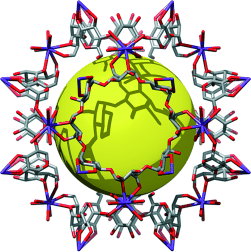Edible gas storage: Porous metal-organic framework made from food-grade natural products

(PhysOrg.com) -- A spoonful of sugar, a pinch of salt, and a splash of alcohol - those are the ingredients used by scientists to generate a new class of robust nanoporous metal-organic frameworks. However, the sugar is not ordinary table sugar, but γ-cyclodextrin, produced from biorenewable cornstarch.
As Fraser Stoddart and a team of scientists from Northwestern University in Evanston (IL, USA), the University of California in Los Angeles (USA), and the University of St. Andrews (UK) report in the journal Angewandte Chemie, this simple recipe could be the basis for a new class of biocompatible porous crystals made of renewable natural products.
Metal-organic frameworks (MOF) are well-ordered, lattice-like crystals. The nodes of the lattices are complexes of transition metals (such as copper, zinc, nickel, or cobalt); organic molecules make up the connections between the nodes. Within their pores, the MOFs can store gases such as hydrogen or carbon dioxide. Furthermore, they can be used for separation of materials, for catalysis, or for the targeted transport of drugs in the body. Most previously prepared MOFs are made of building blocks that stem from petrochemicals. Stoddart and his team set themselves a challenge to synthesize MOFs from natural products. “The problem is that natural building blocks are generally not symmetrical,” according to Stoddart, “this lack of symmetry seems to prevent them from crystallizing as highly ordered, porous frameworks.”
γ-Cyclodextrin provided the solution to this problem: it comprises eight asymmetrical glucose residues arranged in ring, which is itself symmetrical. In many countries (for example the USA and Japan), cyclodextrins are approved for use as food additives. The second ingredient in the frameworks is an alkali metal salt. Suitable candidates include ordinary table salt (sodium chloride), the common salt substitute potassium chloride, or potassium benzoate, an approved preservative. These ingredients are dissolved in water and then crystallized by vapor diffusion with an alcohol. It is even possible to use commercially available sources such as grain alcohol. “These ingredients are all substances that can be obtained cheaply, in high quality, and of food-grade purity,” says Stoddart.
The resulting crystals consist of cubes made from six γ-cyclodextrin molecules that are linked in three dimensions by potassium ions. These cubes are perfectly arranged to form a porous framework with easily accessible pores. “This arrangement is a previously unknown one,” says Stoddart. “The pore volume encompasses 54% of the solid body.” Particularly atypical of porous materials is the fact that when dissolved in water, the framework simply dissociates back to its components, which can then be crystallized again with alcohol. Says Stoddart: “In this way a degraded framework can easily be recycled or regenerated.”
More information: J. Fraser Stoddart, Metal-Organic Frameworks from Edible Natural Products, Angewandte Chemie International Edition, dx.doi.org/10.1002/anie.201002343
Provided by Wiley


















